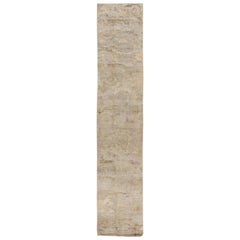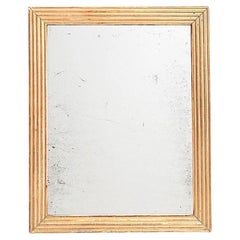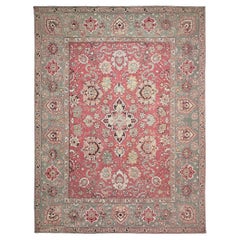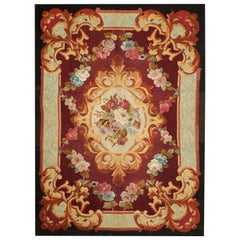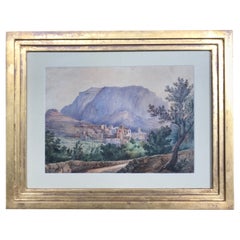New York
to
227
2,111
15,579
9,798
139,976
136,075
66,527
56,510
38,269
22,036
20,173
16,333
13,176
12,586
11,439
9,365
8,239
6,709
6,317
5,834
5,412
3,433
2,752
2,156
2,111
2,027
1,851
1,808
1,374
857
786
604
478
401
348
311
261
239
195
178
176
146
128
116
115
81
66
63
59
58
45
26
20
20
18
12
12
8
8
7
7
7
7
5
4
1
23
11
11
10
9
Period: Mid-19th Century
Period: 1860s
Pair of French Porcelain Green and Salmon Ground Portrait Vases, circa 1850
Located in New York, NY
With fine gilding and gilt swan handles. The portraits with beautifully detailed portraits.
Category
1850s French Antique New York
Materials
Porcelain
Doris Leslie Blau Antique Chinese Hand Knotted Silk Runner Fragment
Located in New York, NY
Antique Chinese hand knotted silk runner (fragment)
Size: 2'0" × 11'0" (60 × 335 cm)
This particular piece was woven by a skilled artisan circa 1850s and shows a lot of elements char...
Category
Mid-19th Century Chinese Antique New York
Materials
Silk
Gold GIlt Reed Frame Rectangular Mirror, France, 1830c
Located in New York, NY
1830c French gold gilt reed frame mirror.
Original mirror.
Category
1860s French Antique New York
Materials
Wood
Antique European Flatweave Rug
Located in New York, NY
Antique European Flatweave circa 1850 France.
Category
Mid-19th Century French French Provincial Antique New York
Materials
Wool
Mid 19th Century - Aubusson Rug - French Antique Design - Red with Floral
By Aubusson Manufacture
Located in New York, NY
Mid-19th century handwoven antique Aubusson rug
Material: wool
Dimensions: 260 x 200 cm; 8.5 x 6.6 ft
Boccara Gallery has an important collection of Aubusson rugs from the XVIIIth to the XXth centuries. The style developed in Aubusson is recognized today as one of the most influential of the European rug and tapestries History.
Workshops to produce Aubusson flat-woven rugs were established under the royal warrant in 1743 to manufacture pile carpets primarily for the nobility.
Many weavers who settled in France were Huguenots who had fled Spain during the Inquisition in the early sixteenth century. By issuing the edict of Nantes, Henry IV granted all non-Catholics freedom of worship, thereby protecting the carpet weavers in Aubusson. Aubusson weavers became the finest craftsmen in the world. Louis XIV’s influential Prime Minister Colbert established the long and hard...
Category
Mid-19th Century French Napoleon III Antique New York
Materials
Wool
View of Capri
Located in New York, NY
View of Capri. Gold-framed French watercolor views of Capri entitled, "Ville de Capri - 13 Juillet 1846."
Dimensions: Sight: 12.5" W x 9" H; overall 18.5" W x...
Category
Mid-19th Century Italian Romantic Antique New York
Materials
Paper, Giltwood, Paint
Grotto View of Capri
Located in New York, NY
Grotto view of Capri. Gold-framed French watercolor views of Capri entitled, "Grotto a Capri - Le 24 Octobre 1846,"
Dimensions: Sight: 12.5" W x 9" H; overall 18.5" W x 14.5" H.
Category
Mid-19th Century Italian Romantic Antique New York
Materials
Paper, Giltwood, Paint
Mount Washington, New Hampshire
By Edmund Darch Lewis
Located in Saratoga Springs, NY
Edmund Darch Lewis (1835-1910)
Mount Washington, New Hampshire
50 x 58 inches, signed & dated 1859
Description
The area near Mount Washington in New Hampshire was visited by many ...
Category
1850s Hudson River School New York
Materials
Canvas, Oil
A Highly Rare Pair of Monumental Qing Dynasty Rouleau Porcelain "Dragon" Vases
Located in New York, NY
A Highly Rare Pair of Monumental Qing Dynasty Rouleau Porcelain "Dragon" Vases
A Masterful Display of 19th Century Chinese Artistry:
The mid-19th century Qing Dynasty marked a period of artistic innovation and imperial grandeur, as exemplified by this rare and monumental pair of Rouleau vases. These exceptional porcelain works, notable for their commanding size and vibrant palette, are a testament to the unparalleled craftsmanship that flourished during this era. Embellished with a dynamic tableau of dragons rendered in bold hues of red, green, blue, brown, and yellow, these vases embody both artistic brilliance and the deep cultural symbolism woven into Chinese decorative arts.
Artistic Excellence and Symbolism:
At the heart of these magnificent vases lies a visual narrative that channels the power and mystique of the dragon, a central motif in Chinese culture symbolizing imperial authority, strength, and cosmic energy. The intricate depiction of dragons in motion, intertwined amidst stylized ocean waves, conveys a sense of fluidity and dynamic movement. Each color used—the crimson reds, verdant greens, striking blues, earthy browns, and golden yellows—has been meticulously applied, reflecting a mastery of the high-fired, polychrome enameling techniques perfected during the Qing Dynasty.
The Rouleau form, with its cylindrical body, short neck, and slightly flared mouth, was a favored shape for large-scale vases in the 18th and 19th centuries. The form’s structured elegance allowed for expansive decorative panels, serving as an ideal canvas for intricate, multi-layered designs. This pair demonstrates how artisans skillfully balanced the flowing movement of the dragons with the rhythmic motifs of waves, resulting in a harmonious composition that engages the viewer from every angle.
Craftsmanship and Technique:
These vases represent the pinnacle of porcelain artistry achieved under the Qing Dynasty, showcasing techniques that reflect centuries of refined craftsmanship. The precision in the application of overglaze enamels and the expert manipulation of kiln temperatures to achieve vibrant and consistent coloration are indicative of the expertise within the imperial kilns. The dragons' scales, rendered with remarkable detail, create a textured effect that contrasts beautifully with the smooth, undulating waves, enhancing the three-dimensional quality of the design.
The depth of color and the crisp delineation of each element point to a rigorous and time-intensive process. These qualities signify the involvement of highly skilled artisans who adhered to the imperial standards set by the royal court, ensuring that each piece was a fitting representation of the empire’s wealth and cultural prowess.
Historical and Cultural Significance:
Vases of this caliber were not merely decorative; they were imbued with profound symbolic meaning and often commissioned for imperial use or gifted as prestigious diplomatic offerings. The dragon motif, deeply embedded in Chinese folklore and philosophy, was associated with the emperor himself—known as the "Son of Heaven"—and symbolized his divine right to rule. These vases also reflect the Qing Dynasty's flourishing export trade and the global fascination with Chinese porcelain during the 19th century. European collectors and royal patrons prized such pieces for their artistry and the exoticism they represented, contributing to a legacy that elevated Chinese porcelain to a revered status in the annals of decorative art history.
Provenance and Collectability:
The extraordinary scale, exceptional craftsmanship, and rarity of this pair establish them as museum-quality works. Such vases would have held a place of honor in a palace or wealthy estate, reflecting not only the owner’s status but also an appreciation for the profound cultural and artistic traditions of China. Their provenance—potentially tied to an imperial commission or significant historical collection—underscores their importance as objects of study and admiration.
Provenance:
Private American Collection, acquired in London, circa 1905.
Thence by descent to the current owners
Solomon Treasure...
Category
Mid-19th Century Chinese Qing Antique New York
Materials
Porcelain
Kipp Soldwedel Operation Statue of Liberty Oil Painting
By Kipp Soldwedel
Located in New York, NY
Kipp Soldwedel (American 1913-1999) "Operation Liberty" Statue of Liberty Oil on Canvas
The artist painted this work for the 100th Anniversary of the Stat...
Category
Mid-19th Century New York
Materials
Oil
Large Antique, French Empire Style, Neoclassical Silvered Bronze Chandelier
Located in New York, NY
A large antique French Empire style silvered bronze multi light chandelier embellished with neoclassical motifs.
Category
Mid-19th Century French Empire Antique New York
Materials
Bronze

